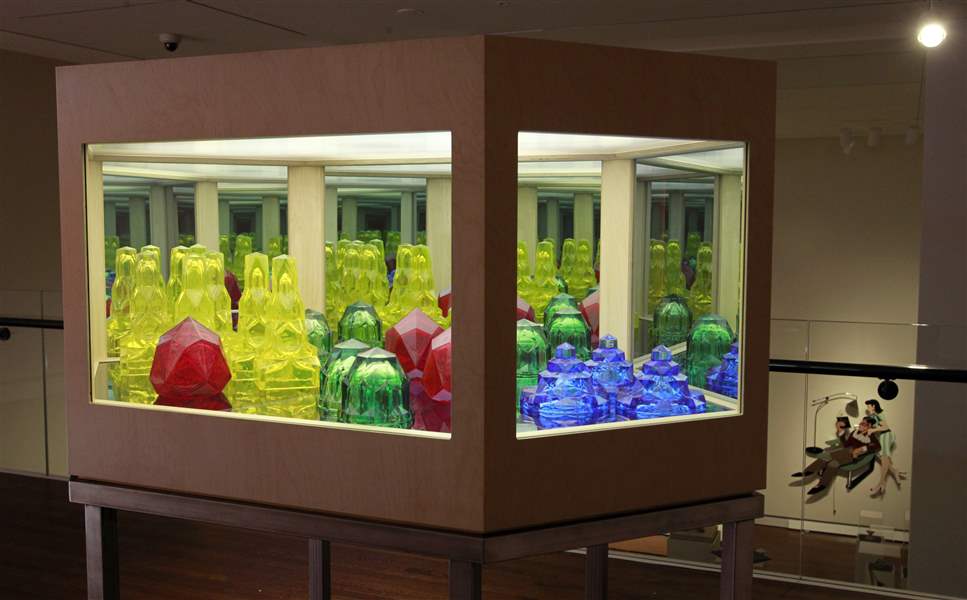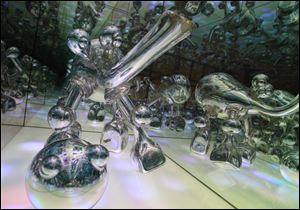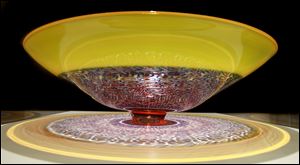
Exhibit celebrates innovations of the studio movement
Gallery debuts at Toledo museum
6/10/2012
‘Crystalline Landscape After Hablik and Luckhardt III’ by Josiah McElheny is among the works in Color Ignited: Glass 1962-2012.
The Blade/Andy Morrison
Buy This Image

Artist Andrew Erdos created ‘Twilight Powered by Electricity … ’
Color meets glass, a match with limitless possibilities, becoming (for starters) intense, opaque, transparent, translucent, reflective, infrared, or ultraviolet.
The exhibit opening Thursday in the new $3 million gallery at the Toledo Museum of Art makes that crystal clear.
There's Radio Light, a glowing rainbow spiraling into itself (made of blown glass, mercury, and argon gas), and Colorbox II, eight tall, narrow panels suggesting CD racks filled with slices of brilliant color; each 30-pound panel carefully baked for days in a kiln.
Color Ignited: Glass 1962-2012, shows off objects that please, tease, and tell the amazing evolution of studio glass from its humble beginnings in a Toledo garage to the glorious ways the world's best artists manipulate it. It's a material that glass pioneer Fritz Dreisbach loves for being "runny, drippy, gooey" and that inventor/artist Dominick Labino said "has absolutely no limits" in terms of color.
It's a big week for shinystuff in the Glass City; for art aficionados it's comparable to the LPGA tournament for golfers. Some 1,200 artists and connoisseurs will gather Wednesday through Saturday at the SeaGate Convention Centre and the museum for talks, demonstrations, the eyeballing of each other's creativity, and fun at the Glass Art Society's 42nd conference. This is the third time the group has held its annual meeting in Toledo; this year with a nod to two historic 1962 workshops held at the museum at which a handful of clay artists, eager to figure out how to melt glass in a small furnace like the kilns they used, met with auspicious breakthroughs.
SPECIAL SECTION: Transformations -- 50 years of glass art

‘Harvey Littleton: Technique is Dear’ by German artist Erwin Eisch is part of the inaugural exhibit in the new Wolfe Gallery at the Toledo Museum of Art.
At the time, glass was primarily the domain of industry, melted in huge furnaces and formed by machines or skilled craftsmen.
Color Ignited is the inaugural exhibit in the Frederic and Mary Wolfe Gallery for Contemporary Art, with soaring white walls (21½-feet), dark oak floors, and a mezzanine. Its 6,065 square feet is at the back of the recently spiffed-up Classic Court, where a new skylight and marble pillars grace antiquities 1,800 to 4,700 years old. The space with its small upper level (served by stairs and an elevator) will handily accommodate video projections, unusual installations, various vantage points, and huge objets d'art.
A happy partner
Despite the fragility of its subject matter, Color Ignited will be fun for kids and adults. Most of these nearly 100 pieces have been borrowed from private collectors, but many are owned by the museum, which began buying studio glass in the 1960s.
It's astonishing how different glass can be made to look by varying the raw materials used to make it, the intensity and duration of heat, substances added to it, and methods for shaping. And it's a heckuva good sport, happily partnering with an array of other materials.
Enter the gallery's oversized doors and you'll face the wow! of Jun Kaneko's Colorbox II (2007). Head right for a visual history of American studio glass, and don't miss the humble beginnings: An island of pedestals hold several simple little greenish pieces made at the 1962 workshop from melting glass marbles invented by Dominick Labino when he worked for Johns Manville.
Hung on a near wall is Dan Dailey's life-sized sculpture: a thickly bespectacled man sits legs crossed, feet slippered, reading a book titled The Principles of Decor, opened to a page about rugs; a curvaceous gal leans in with a cuppa joe. Mr. Dailey didn't make this glass; he carved it from pieces of Vitrolite, a color-saturated, often opaque glass made in the United States by Libbey-Owens-Ford from 1935-1947 but no longer manufactured.

‘Citron Vanishing Gladiator,’ a blown-glass work by artist Stephen Rolfe Powell, is part of the exhibit that opens Thursday.
A don't-miss work is among the most recent in the show, and its creator is probably the youngest. Twilight Powered by Electricity Makes for a Brilliant New Horizon is an elephant/robot with knobby eyes and knees and hints of Seussicality. Andrew Erdos, who blew it and its little round buddy, added sterling silver for a mirrored effect, and placed the pair on a translucent white base under which four rows of LED lights softly cycle through primary colors.
Commissioned by the museum, it was blown in hollow segments and fused together, said the museum's glass curator, Jutta-Annette Page.
Cross-over artists
Also on view will be early and later pieces by the famous Dale Chihuly, aboriginal-inspired plates that Klaus Moje made by fusing and grinding mosaic glass, and a gorgeous blue rectangle by Mr. Moje's fellow Australian Giles Bettison. A close look at Mr. Bettison's ruglike rectangle shows hundreds of one-inch squares, each a piece of murrine glass, made by layering different colors of molten glass around a core, heating it, and stretching it into a rod. When cool, the rod is sliced, and each piece holds a cross-section of color.
Although studio glass in its early decades was largely a male domain, the exhibit includes a handful of pieces by women. Toots Zynsky made bowls by heating and fusing pigmented glass threads, and Ginny Ruffner's playful Beauty as Drama #141-52 was flameworked (made by holding glass rods or tubes in a gas-fired flame, usually at a table, until the rods are soft enough to manipulate).
But not all artists make their own glass. Fred Wilson designed the 8½-foot black Iago's Mirror with intricate detail similar to an 18th-century mirror, and he worked closely with the Italian artist who fashioned its four black, plate-glass pieces in diminishing sizes. And Frogs, 63 wee amphibians cast from a single mold, was designed by Kiki Smith and crafted by an artist she hired.
"There are more and more artists who are crossing over, conceiving of a design and having someone else make it," Ms. Page said.
Adding flexibility
Like many U.S. museums established a century ago, Toledo's built a strong European collection but was weak in other areas such as non-European and modern art. In recent years, it has bought more 20th and 21st-century objects, but there was scant space to show them.

‘Crystalline Landscape After Hablik and Luckhardt III’ by Josiah McElheny is among the works in Color Ignited: Glass 1962-2012.
"We haven't had much flexibility [for big pieces]," said Kelly Garrow, a museum spokesman, adding that the vaults contain a far higher percent of contemporary works than of other collections.
The Wolfe Gallery space displayed the museum's glass collection from 1970 to 2003, when it was emptied and its objects were examined and conserved in preparation for their 2006 reinstallation in the museum's new 76,000-square-foot Glass Pavilion across Monroe Street.
The former glass gallery, renovated in the late 1960s, combined two galleries into one, with a ramp leading to a wrap-around mezzanine.
Planning began in 2007 with demolition, including removal of most of the mezzanine, in 2008. Stripped to the studs, it sat locked and vacant while potential donors were taken in and asked to imagine what it could be.
Mary and Frederic "Fritz" Wolfe could imagine it, and in 2010 donated $2 million to build it. The Wolfes of Perrysburg are longtime benefactors of arts and education. An additional $1 million was supplied by the museum's capital budget.
Simple but complex
Over the five-year course of the project, the Toledo architectural firm hired to do the work split, but Duket Architects Planners and Thomas Porter Architects collaborated on design and execution.
"We wanted to create a space that was unique from any other space in the museum and that would have multiple vantage points," said Steve Shrake, senior project architect/manager at Thomas Porter Architects.
It had to be flexible, able to accommodate hulking pieces of art as well as parties or lectures. So doors are oversized, an acoustic plaster ceiling quiets the noise, and a speaker system is concealed. And because contemporary art is often plugged in, electrical outlets were installed in the floor and behind panels in a "raceway" at floor level.

Jane Bruce’s creations are among the nearly 100 works in Color Ignited. Some have been borrowed from private collectors but many are owned by the museum, which began buying studio glass in the 1960s.
"We made the gallery as simple as possible so the architecture does not overpower the art," Mr. Shrake said. But simple designs are often the most complicated to execute, he noted, because the smallest details, such as outlets or speakers, can spoil the look. God, as architect Mies van der Rohe said, is in the details.
After Color Ignited closes Sept. 9, the new gallery will be dark until early 2013 and eight small adjacent rooms devoted to contemporary works will be emptied. Amy Gilman, curator of contemporary art and associate director of the museum, is developing a plan for rearranging objects in the eight galleries as well as in the Wolfe; a reopening is expected in late January.
A companion book to the Color Ignited exhibit and with the same name is packed with beautiful photographs including most of the exhibited objects.
Its 208 pages include essays by Ms. Page and two others about the half-century evolution of studio glass. It can be purchased for $39.95 in the museum store.
In addition, thousands of pieces of glass have been moved and are displayed in different ways in the Glass Pavilion (also Ms. Page's project), the Chihuly chandelier at the front door has been cleaned, new glass-melting furnaces were installed in its popular hot shop, and the Glass Study Room was updated with new computers for public use and a time line of the history of glass.
Contact Tahree Lane at tlane@theblade.com or 419-724-6075.